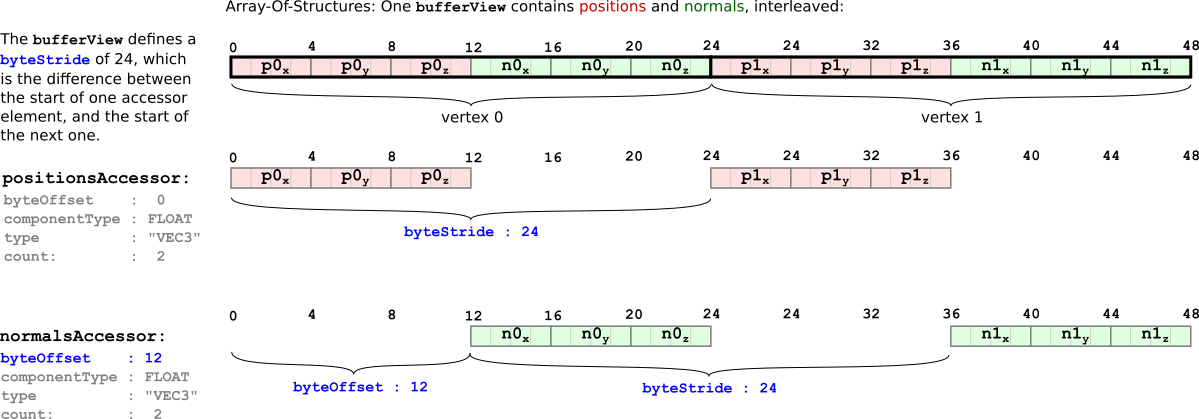Why are BufferViews and Accessors separate in glTF?
The GLTF format specifies that meshes reference their vertex and index data via accessors, which in turn reference BufferViews. Both of them have an offset and a length.
The main difference seems to be that BufferViews are format-agnostic, they just reference a bunch of bytes, while the accessors are adding type information.
What I do not understand is:
- Why do both of them need an offset and a length? Which use case is there where the offset in an accessor is not zero and the count of an accessor does not correspond to the length of the view?
- Why isn't the type data directly contained in the buffer view? In what use case does it make sense to interpret the same data with different formats?
The format is designed to support interleaved vertex attributes, initially from WebGL (in glTF 1.0) but now more generally across graphics APIs (in glTF 2.0).
For example, POSITION data may be a vec3 of FLOAT, but TEXCOORD_0 data may be a vec2 of FLOAT, and there could even be custom attributes of different types, all interleaved within a single GPU buffer.
So the BufferView defines a given byte stride, and the individual accessors into that view may have different types and amounts but will all share the same byte stride.
You're not required to interleave of course, but the format is designed to allow it, and to enforce the byte stride sharing when it happens.
Here's a diagram from the Data Interleaving section of the glTF tutorial. It's a little small here but you can click for a larger view. In this example, there are two accessors, one for POSITION and one for NORMAL, sharing a single BufferView.
- Zoom and translate an Image from the mouse location
- How to make the Youtube's rotating spinner loading screen on Java Swing
- Determine the block compression format of an existing DDS texture file
- Raytracer Reflection: object is dimmed, not reflective
- When does the transition from clip space to screen coordinates happen?
- Accessing every cordinate on a plane in random order, uniquely efficiently in time and space
- Java2D: Increase the line width
- How can I find the intersecting point of three planes?
- Python opencv draws polygons outside of lines
- How can i find out where a BufferedImage has Alpha in Java?
- Reproducing lattice dendrogram graph with ggplot2
- DirectX distorted/stretched triangle render
- Rotate a Graphics bitmap at its center
- C# Create Grid For Painting Pixels and Rendering Text
- Writing BMP image in pure c/c++ without other libraries
- What does the GL_ARRAY_BUFFER target mean in glBindBuffer?
- Do I need to gamma correct the final color output on a modern computer/monitor
- How to draw a decent looking Circle in Java
- What is this vector overlay format?
- What's the point of having a single vertex attribute?
- k-way triangle set intersection and triangulation
- Displaying SVG in OpenGL without intermediate raster
- How to tell whether an OpenGL context is hardware accelerated?
- how to change thousands separator for blank in R plotly?
- How do you calculate the axis-aligned bounding box of an ellipse?
- Why computed prefilter radiance map looks different in opengl api comparing to dx11?
- How to deal with horizontal edges in polygon scanline algorithm?
- why does the difference quotient where h = FLT_MIN always equals 0? How can I add the smallest number possible to a float?
- PNGDecoder in LWJGL returning few negative values
- Associating B-Spline Coefficients to Control Points
